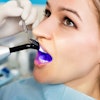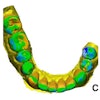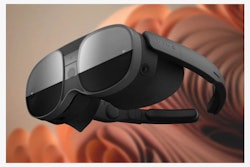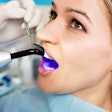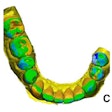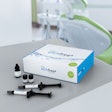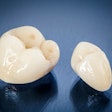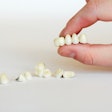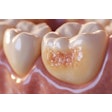Composite resin restorations are an integral part of restorative dentistry today. The versatility and capacity to instantly restore teeth make composite an invaluable material.
The advent of reliable adhesives allows restorative dentists to push the envelope for minimally invasive, conservative treatment with composite resin.
However, when completing resin restorations, clinicians need to ensure they create a highly polished end result to ensure tissue health and maintain the restoration's aesthetics.
The award-winning OneGloss PS Polishing System by Shofu is a simple and very effective product that can be used to create anatomy and yield a highly polished restoration.
 Dr. Priya Tirumalasetty.
Dr. Priya Tirumalasetty.
It is a one-step finishing and polishing system manufactured in three different shapes: a cup, a midi-point, and the IC, a disc shape. The points can be purchased individually or in an assorted kit. Each of these shapes is very useful for contouring and polishing composites anywhere in the mouth.
For posterior restorations, the cup and point are useful for finishing and polishing in one step. For example, after completing a class II resin in the posterior, the patient may feel that the new restoration is "gritty" if it has not been polished.
A few quick passes with a OneGloss PS point or cup will finish and polish the restoration to yield a smooth surface that is much less noticeable to the patient. When used on a slow-speed handpiece with water spray, a firmer pressure will remove the composite, while a softer pressure will polish the restoration to a satin finish.
With posterior restorations, there is no need to follow with another polishing tool. The OneGloss PS polishing system saves the clinician chair time by reducing the number of steps needed to complete the restoration.
The OneGloss PS polishers are also very useful for hygiene appointments. When a hygiene patient requests a rough or stained restoration to be polished, it is a hassle to set up multiple handpieces. Setting up another operatory solely for polishing a restoration can be time-consuming and inefficient.
Keeping OneGloss PS polishers stocked in the hygiene room ensures greater convenience and efficiency. Clinicians can efficiently polish restorations using a slow-speed attachment and a single polisher, selecting the polisher shape based on the restoration's location. For instance, cervical restorations often accumulate stains at the margins due to rough surfaces that trap discoloration. These stains can be easily removed, and the rough margins smoothed, using a OneGloss PS midi-point. Adjusting pressure allows for effective stain removal and refinement of the restoration’s surface.
For anterior restorations, OneGloss PS points are invaluable for creating detailed anatomy and achieving a polished final result. The bullet-shaped midi-point is particularly effective for forming depressions that mimic the natural appearance of lobes. Without these elevations and depressions, anterior teeth can appear flat and unnatural.
Varying pressure with the midi-point allows for precise results: Firmer pressure creates depressions, while lighter pressure removes scratches left by burs. If a bur is initially used to form depressions, the OneGloss PS midi-point is an excellent next step for contouring and polishing these areas.
The IC, or disc, is ideal for polishing interproximal surfaces and refining rough or squared corners, while the OneGloss PS cup is highly effective for removing bur scratches and finishing and polishing the lingual surfaces of anterior teeth, as well as the occlusal and lingual surfaces of posterior teeth. The cup serves as a perfect final step after occlusal adjustments with a carbide bur.
For a comprehensive polishing protocol, OneGloss PS polishers can be used alongside Shofu's Super-Snap Polishing Disks. This combination is essential for polishing chairside composite veneers, which require a highly polished finish that closely resembles ceramic restorations. As composite veneers continue to gain popularity, this comprehensive protocol ensures a natural and aesthetic result.
The OneGloss PS Polishing System was recently evaluated by Catapult's team of evaluators, with a focus on its usability, performance, and overall impact on dental procedures.
Evaluators noted that integrating OneGloss PS polishers into their daily workflows was seamless, highlighting the system's exceptional user-friendliness and intuitive design. One of the standout features is the ability to switch from cleaning to polishing with a simple change in pressure. This versatility was seen as a significant advantage in clinical settings, allowing for greater flexibility and efficiency.

One evaluator mentioned, “The OneGloss PS system simplifies the polishing process, delivering a smooth finish with minimal effort.” Another evaluator stated, “… being able to switch from cleaning to polishing with just a change in pressure is a game changer in clinical settings.”
In terms of overall satisfaction, the majority of evaluators expressed that OneGloss PS significantly improved their workflow efficiency and patient outcomes. The ease of use and the superior finish it provides were frequently highlighted as key benefits. Feedback such as “The polished surface is incredibly smooth and aesthetically pleasing,” underscores the positive impact of incorporating OneGloss PS into daily practice.
As dental professionals, clinicians are open to incorporating tools that can enhance efficiency while improving patient care. Comprehensive feedback from Catapult evaluators indicated that OneGloss PS polishers made a substantial impact in simplifying the polishing process and delivering high-quality results with minimal effort.
The strong positive endorsements from evaluators earned the OneGloss PS polishing system the Catapult Vote of Confidence™. The system proved to be indispensable in improving efficiency and providing a great outcome for patient care.
Note: Learn more about the product below in an interview with the clinician.
 Figure 1: Creating lobes and depressions.Images courtesy of Dr. Priya Triumalasetty.
Figure 1: Creating lobes and depressions.Images courtesy of Dr. Priya Triumalasetty.
 Figure 2: The ShofuOne Gloss Point that was used to create lobes.
Figure 2: The ShofuOne Gloss Point that was used to create lobes.
 Figure 3: An incisal view to evaluate lobes.
Figure 3: An incisal view to evaluate lobes.
 Figure 4: A polished tooth.
Figure 4: A polished tooth.
Dr. Priya Tirumalasetty (Dr. Setty) is a 1997 graduate of the University of Michigan School of Dentistry. She completed a general practice residency at Lehigh Valley Hospital in Allentown, PA. Dr. Setty has a private practice in Chicago. She is a fellow and master of the Academy of General Dentistry and an accredited member of the American Academy of Cosmetic Dentistry. In 2023, Dr. Setty completed the required courses to become a graduate of the prestigious Kois Center. She is a member of the Catapult Education Speakers Group.
The comments and observations expressed herein do not necessarily reflect the opinions of DrBicuspid.com, nor should they be construed as an endorsement or admonishment of any particular idea, vendor, or organization.
